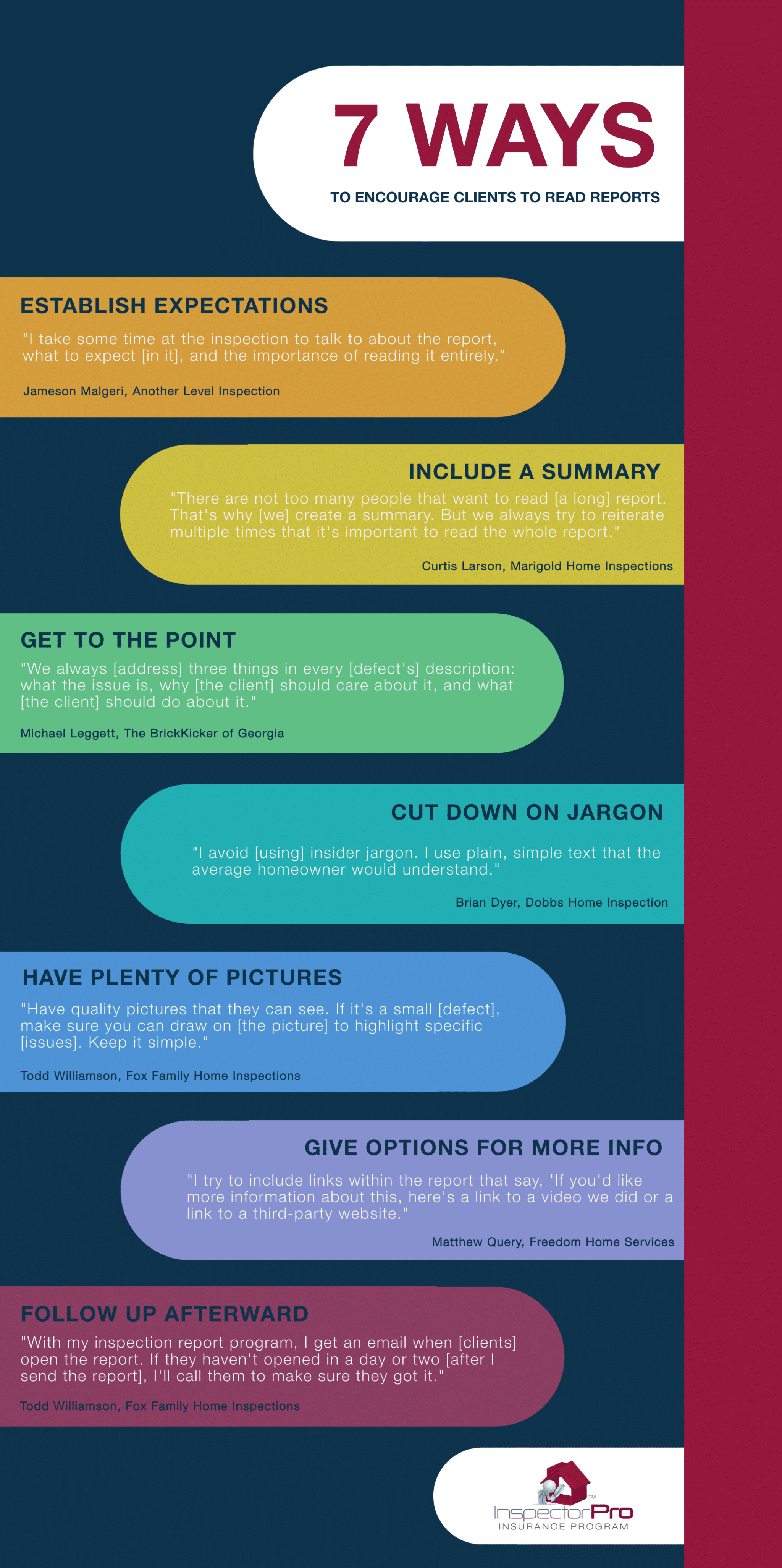7 Ways to Encourage Home Inspection Clients to Read Reports
Last Updated November 9, 2023

Clients in the home inspection industry are notorious for not reading their inspection reports. And, when they neglect to read their reports, they are more likely to complain and file claims.
Michael Ashburn from Ashburn Inspections, LLC in Pennsylvania can attest.
“People who call and complain about my inspection are usually the people [who] don’t read the report,” Ashburn said.
He isn’t alone. Many other home inspectors have had clients assert that they missed something during the inspection when, actually, the defect was carefully outlined in the report.
By interviewing your fellow inspectors, we bring you answers to why clients don’t read their inspection reports and what can be done to encourage them to do so.
Why don’t clients read their inspection reports?
There are a whole host of reasons why clients choose to not read their home inspection reports. However, according to our interviewees, we found the following reasons to be the most common:
 They don’t understand the language used in the report and, therefore, don’t have interest in reading it in its entirety.
They don’t understand the language used in the report and, therefore, don’t have interest in reading it in its entirety.- Clients feel like they are too busy to read their reports—especially during a real estate transaction.
- They don’t want to receive bad news, so they put off reading the report.
- Real estate agents discourage home inspection clients from reading the report because they don’t want the sale to fall through.
Ultimately, all of these reasons boil down to clients associating their inspection reports with stress in some form. Once you understand this, you can start to ask the right questions, like:
- How can I communicate the importance of the report?
- How can I make my reports easier to read?
- What can I do to help after I send over the report?
Fortunately, the inspectors we interviewed had some answers.
How You Can Provide Encouragement
The following seven tips are proven methods to encourage clients to read their inspection reports.
Establish expectations.
As a home inspector, setting expectations is essential to helping clients understand that the reports are valuable to them.
Jameson Malgeri from Another Level Inspection in Massachusetts has found that when he establishes expectations about his inspection reports, his clients are more likely to read them.
“I take some time at the inspection to talk to about the report, what to expect [in it], and the importance of reading it entirely,” he said.
In addition to communicating that inspection reports include crucial information about defects, Ashburn explains that he, the inspector, writes the report. By underscoring that he’s the author, Ashburn helps his clients better appreciate the information and expertise in his reports.
“I tell my clients, ‘I do the inspections, I generate the report—no outside help,’” Ashburn said. “People are astounded.”
If clients understand that you have taken the time to thoughtfully convey findings that are key to keeping them safe, they will see the value in reading their reports.
Read more about the importance of establishing expectations in managing risk in our article “How to set home buyers’ expectations”.
 Include a summary.
Include a summary.
Sometimes it isn’t enough to just express how much work and key information go into your report. That’s where an inspection summary can help. Almost every inspector we interviewed suggested having a summary in clients’ inspection reports.
But not every summary is created equal. You need to do more than simply giving a brief description of how the inspection went. The strongest summaries clearly state the greatest issues of the inspected property. And, to help guide clients to the body of the report, Curtis Larson from Marigold Home Inspections in Minnesota links his summary items to their corresponding pages in the full-length report.
Finally, a complete summary reiterates that it isn’t a substitute for reading the entire report. Larson says as much in his own summaries and in person.
“We create a snapshot [of the inspection] with our summary, but we also [state] that it’s important to read the whole report,” Larson said.
Get to the point.
After including a solid summary, encourage your clients to read the rest of your report by getting straight to the point. For example, you can cut out unnecessary fluff by writing about defects.
“We always [address] three things in every [defect’s] description: what the issue is, why [the client] should care about it, and what [the client] should do about it,” said Mike Leggett from The BrickKicker of Georgia.
Then, take the time to go back and review the writing in your report. Not only will you be able to cut out unnecessary wording, but you will also have the opportunity to be more direct and catch misleading phrasing, thereby mitigating your risk.
For additional best practices in writing reports, read our article “Inspection Report Writing: 8 Best Practices”.
Cut down on jargon.
 Another way you can be more direct and improve the clarity of your reports is by cutting down on industry-specific jargon. Clients are more inclined to read their reports when complicated terms are either explained or removed.
Another way you can be more direct and improve the clarity of your reports is by cutting down on industry-specific jargon. Clients are more inclined to read their reports when complicated terms are either explained or removed.
“I avoid [using] insider jargon. I use plain, simple text that the average homeowner would understand,” said Brian Dyer from Dobbs Home Inspection in North Carolina.
For example, the “average homeowner” may not be familiar with terms such as:
- Names of systems, components, or structures: flashing, subpanel, joists, GFCI/AFCI, weep holes, etc.
- Names of defects: alligatoring, EIFS issues, latent moisture, S-trap, etc.
- Tools used in the inspection: moisture meter, thermal imaging camera (IR camera), endoscope, etc.
Even if clients have heard of certain terms, they may not know what they mean in the context of your inspection. If you decide to use industry-specific terms, we advise that you explain what each term means and why it is significant to the inspection.
To learn more about writing a report your client can understand, check out this article.
Have plenty of pictures.
Even when cutting down on jargon, it can be difficult for clients to understand what you’re referring to. Help clients visualize the defects and the systems and components you reference in your report by including plenty of pictures.
“Have quality pictures that they can see,” said Todd Williamson from Fox Family Home Inspections in Georgia. “If it’s a small [defect], make sure you can draw on [the picture] to highlight specific [issues]. Keep it simple.”
When you include pictures that clearly outline the defects that are present, you provide an additional way for your clients to understand your findings.
To learn more about which kinds of pictures you should include in your report, check out our article “3 inspection photos you should take to manage your risk.”
 Give options for more information.
Give options for more information.
Unfortunately, it isn’t possible to explain everything your client could have questions about in your report. And, since many clients don’t have a background in the trades, they may need more background on various aspects of your report. That’s why we recommend you direct clients to supplemental materials.
“I try to include links within the report that say: ‘If you’d like more information about this [system or component], here’s a link to a video we did or a link to a third-party website,” said Matthew Query from Freedom Home Services, LLC in North Carolina.
Our only caution with this practice is to avoid including an unwarranted amount of links. Be intentional with the links you provide. Keep them pertinent and helpful. Look to industry authorities. By referencing helpful resources in your inspection reports, you also add to your credibility.
Follow up afterward.
Once you have a report that is easy to read, the inspectors we interviewed said they follow up with clients to see if they have questions about the report.
“With my inspection report program, I get an email when [clients] open the report,” Williamson said. “If they haven’t opened in a day or two [after I send the report], I’ll call them to make sure they got it.”
Garrett Scott from Abode Solutions in Alabama likes to email clients to see if they have any questions or concerns about his reports. And, if they do, he sets up a video call with them and their realtor.
“We set up a video conference that I host through my website,” Scott said. “I’ll go through everything [they have questions about].” In addition to it being great customer service, following up gives you a chance to dispel any confusion, thereby diffusing most complaints before they can arise.
Mitigate Risk by Helping Clients Read Reports
Although there is no hard-and-fast way to encourage your inspection clients to read their reports, there are some methods you can apply. Whether you’re establishing expectations, improving readability, or following up, helping your clients read their reports will increase customer satisfaction and reduce your risk.
Interested in learning more about how you can diffuse complaints? Read about our pre-claims assistance program in our article, “Pre-Claims Assistance: The FAQs.”






